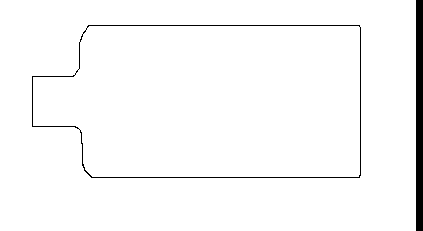
Heterokaryotic A + a cultures of N. tetrasperma produce ascospores more quickly and abundantly than A x a crosses in heterothallic species such as N. crassa. In the course of studying ascospore structure and physiology in the 1950's and 1960's, methods were developed that enabled us to obtain gram-quantities of air-dry spores. Details of the procedure never were published and it has been suggested that I do so now for the benefit of those who may want to obtain ascospores in large quantities.
Our ascospore "factory" was set up with 8-ounce medicine bottles, bought by the case, as the container for growing the spores. Their shape, from above, is as in the diagram below. We used such bottles, which happened to be brown, because they have a large surface area, and are cheap and easily stacked. It surprised us how few of these non-Pyrex bottles broke in autoclaving during our long use of them.

The medium (PYM) we used was as follows: 6.0% potato dextrose agar, 0.5% yeast extract, 0.5% malt extract. Usually, we used Difco materials.
Each bottle contained 50-60 ml of PYM, cotton stoppers were used, and autoclaving was done in the usual way. The bottles were allowed to solidify before inoculation was performed. The medium should not be allowed to dry at room temperature for more than two days before use, and I suspect that in climates with low relative humidity drying should not proceed for more than one day. Therefore, bottles with medium should be stored in the cold if they aren't used quickly, except that this leads to condensation that, in turn, could induce contamination and to more difficulty in seeing what's inside the bottles.
Inoculation was performed with 3-4 ml of heavy suspensions of conidia. It is important to spread the inoculum over the entire surface of the flask because adding enough inoculum is essential to permit spreading by rolling the liquid along the surface. The latter technique avoids the difficulties caused by opening the bottles and using a spreader.
Incubation was accomplished by keeping the cultures in the dark at 25-27 C, with the agar side at the bottom for 1-2 days, after which the agar side should be placed uppermost.
Harvesting was done after 30-32 days, which, under our conditions, yielded the best results. We added 60-100 ml of distilled water to the first bottle and used a flat plastic or rubber scraper to move the ascospores into suspension. This fluid was poured into the next bottle and the process repeated until the suspension got too heavy. This usually happened after about 15 bottles had been rinsed. At that point, the suspension was poured into a powder funnel lined with copper screening (1/32" mesh) which rested in the mouth of a 500 ml or 1 liter cylinder or flask. When the cylinder was full, we replaced it with an empty one and let the spores settle in the original one. After the settling occurred, the supernatant was decanted and the cylinder used again as above. We usually rinsed the bottles a second time using the same technique. It helps not to loosen the agar during this process in order to avoid getting pieces of it, mycelium, and scraps of perithecial walls that settle with the spores and block the pores of the screen.
Cleaning the ascospores was accomplished by repeated (we usually used 5 cycles) settling, decanting and resuspension to remove unwanted materials. Then the spores were shaken in 0.8 EDTA at pH 6.8-7.0 on a reciprocal or rotating shaking machine in a cold room. The EDTA should be changed at two-day intervals for about a week. Upon changing the EDTA solution, carefully decant the suspended matter each time. Several changes of distilled water should be used to replace the EDTA when the shaking is concluded.
This process gave us excellent germination and seemed to get rid of residual contaminants, including conidia. Storage of spores is possible indefinitely at 4 C. The spores can be air-dried and stored on filter paper or in small bottles but germination is more rapid and complete when they are stored in water for at least a week.
I wish to thank Dr. David Perkins for the suggestion that I publish this material. In addition, I am grateful to the late Dr. David Goddard for developing many of the techniques given herein and to Ms. Tracy Jepson for helping to refine them.